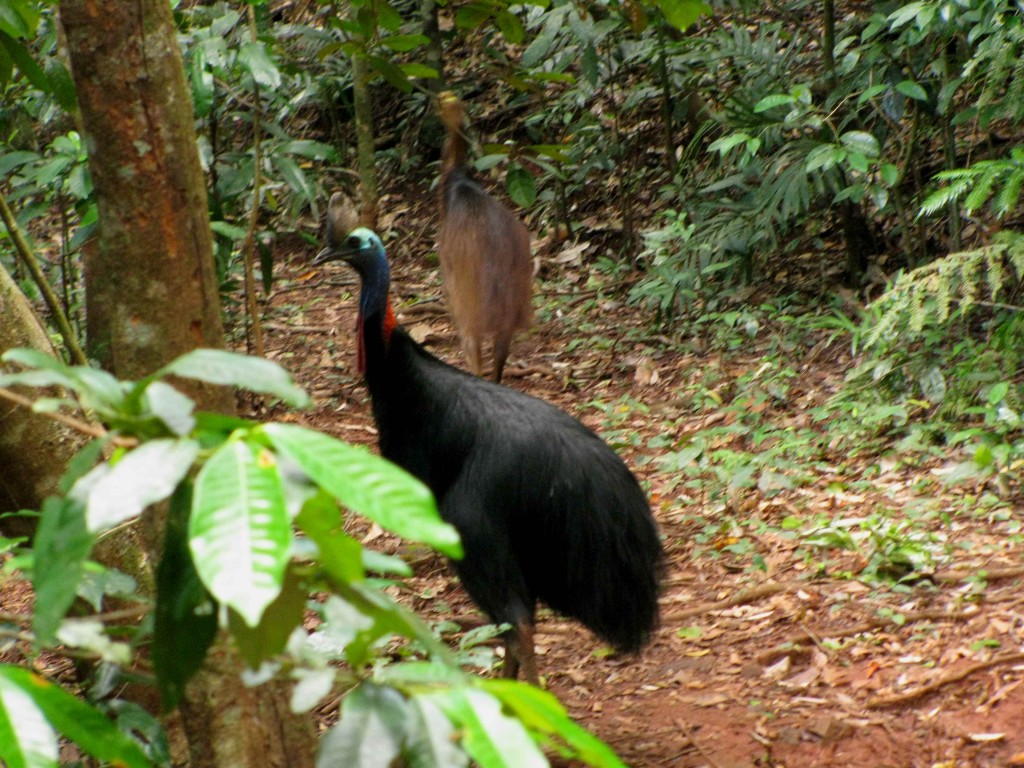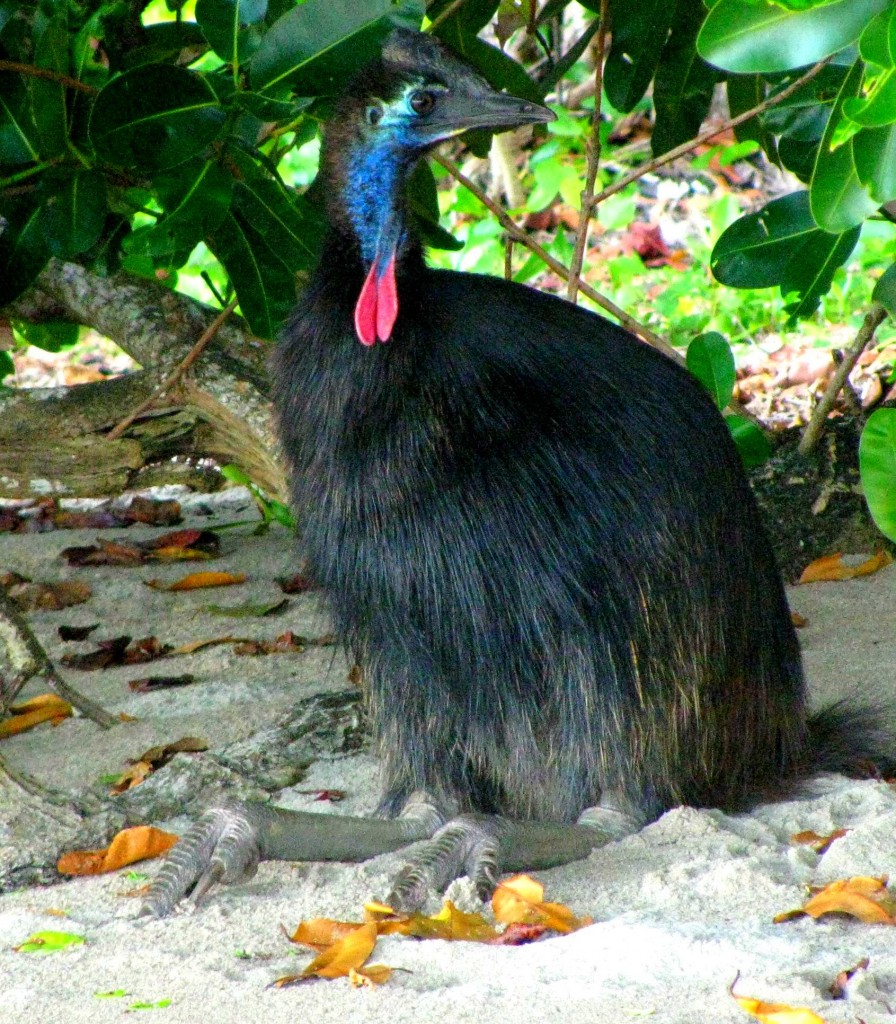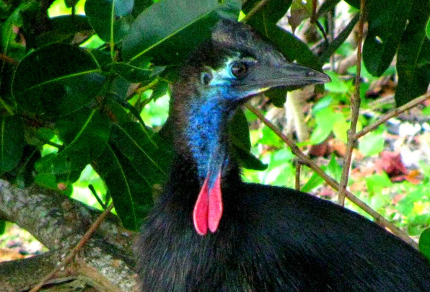Oh, blessed freshness after the rain! Last evening’s wild storm – its black power like an invading enemy – has granted Townsville a reprieve from heat and scorching sun. This morning, lighter cloud blanketed the city while Vilis and I cycled to James Cook University, he to his work, and I to complete some library research.
While reading old JCU Discover magazines, I stumbled upon an article that discussed the devastating impacts another and much larger storm – Severe Tropical Cyclone Larry – had on southern cassowary populations in 2006.1 Larry was a Category 4 cyclone that slammed into the Queensland coast near Innisfail, which is located about 250 kilometres north of Townsville and 90 kilometres south of Cairns.2 The cyclone made landfall during the morning of Monday, March 20 and pounded the Cape York Peninsula for four days, dumping staggering amounts of precipitation as it travelled westward, the maximum 24-hour total hitting 435 millimetres at Greta Station inland from the coast.2 Massive flooding occurred in the wake of the cyclone, with the Bruce Highway, the main north-south highway on Queensland’s east coast, swamped by water for four days in the Tully area and overtopped by the raging Mulgrave River at Gordonvale, where the river peaked at 15.2 metres and topped the highway by a metre.2 Violent winds with gusts estimated at 240 kilometres per hour toppled trees or stripped them of branches, severely damaged buildings, and flattened banana plantations.2 Communities were isolated due to flooding; however, although food drops were necessary and non-serious injuries were sustained, no human lives were lost.2
The same cannot be said for the southern cassowaries inhabiting the region. At Mission Beach near Tully, 100% of the cassowary chicks and 35% of the adult and sub-adult cassowaries died as a result of the cyclone, which destroyed their food source (rainforest fruits) and exposed them to danger as they sought food outside their normal rainforest habitat.1 Of the confirmed post-cyclone cassowary deaths recorded, 70% were due to vehicle-cassowary crashes, and 22% due to attacks on cassowaries by dogs.1

Southern Cassowaries, Jindalba Track, Daintree National Park, Queensland (© Vilis Nams)
Southern cassowaries are an endangered species, with as few as 1200 remaining in the wilds of rainforests vegetating the east coast of the Cape York Peninsula in Far North Queensland.1 Generally uncommon, these huge, flightless birds may nonetheless occur commonly in undisturbed rainforest habitats containing their preferred fruiting trees and shrubs.3 The Mission Beach area is as a hotspot for cassowaries due to its protected remnants of lowland rainforests rich in preferred fruits. One example is the forest dominated by Licuala fan-leaved palms in Licuala State Forest Park near Mission Beach, where in August, Vilis and I searched for and found a cassowary and an abundance of seed-filled cassowary droppings that indicated a much larger population than we had observed (see August 21 post, http://maginams.ca/2010/08/21/ ). In contrast, despite the signs advising of ‘cassowary country’, Vilis and I have never seen a cassowary dropping on the rainforest tracks around Paluma, which we’ve hiked on a half-dozen occasions, and we spotted only one dropping on the Jindalba track in Daintree National Park, where we also fortuitously observed two cassowaries ahead of us on the track.
If the Mission Beach cassowary population sustained such heavy losses due to Severe Tropical Cyclone Larry, it’s likely other populations within the affected stretch of coastal wet tropics, where the cassowaries tend to occur in distinct sub-populations associated with particular pockets of undisturbed habitat, were affected as well. Losses due to the cyclone are compounded by a low cassowary reproductive rate, which will make their post-cyclone recovery a slow process, if it occurs at all.1
In the Discover article, JCU cassowary researcher Nicky Moore hypothesized that 6 of the 8 sub-populations of cassowaries may go extinct within 60 years, and two of those populations might face extinction within 25 years.1 Why? Those highly endangered sub-populations are crowded into patches of rainforest that are too small to support them, and vehicle crashes and dog attacks are killing more birds than can be replaced by reproduction.1 With a severe cyclone like Larry compounding the situation by destroying food sources and eliminating an entire crop of chicks, that makes the future of the southern cassowary look even grimmer.1

Southern Cassowary, Etty Bay, Queensland (© Vilis Nams)
Ironically, researchers studying the ecology and distribution of these endangered and iconic Australian birds receive far less funding than do researchers studying the koala, another Australian icon, but one that is far more numerous, with perhaps 300,000 koalas occurring in Queensland alone.1 Setting aside the issue of the koala’s cuteness and public appeal versus the cassowary’s stately beauty, southern cassowaries play a pivotal role as seed dispersers in Australian wet tropics rainforest ecosystems. If Australia loses the cassowary, the continent’s biodiversity will drop by a factor much larger than just one species.
References:
1. James Cook University. Big bird blasted by Larry. JCU Discover Magazine, November 2007, p. 7.
2. Australian Government, Bureau of Meteorology. Severe Tropical Cyclone Larry. Updated Mar-2007. Accessed 22-Nov-2010. © Commonwealth of Australia 2010, Bureau of Meteorology. http://www.bom.gov.au/qld/cyclone/tc_larry/
3. Graham Pizzey and Frank Knight. The Field Guide to the Birds of Australia. 1997. Angus & Robertson, Sydney, p. 18.


